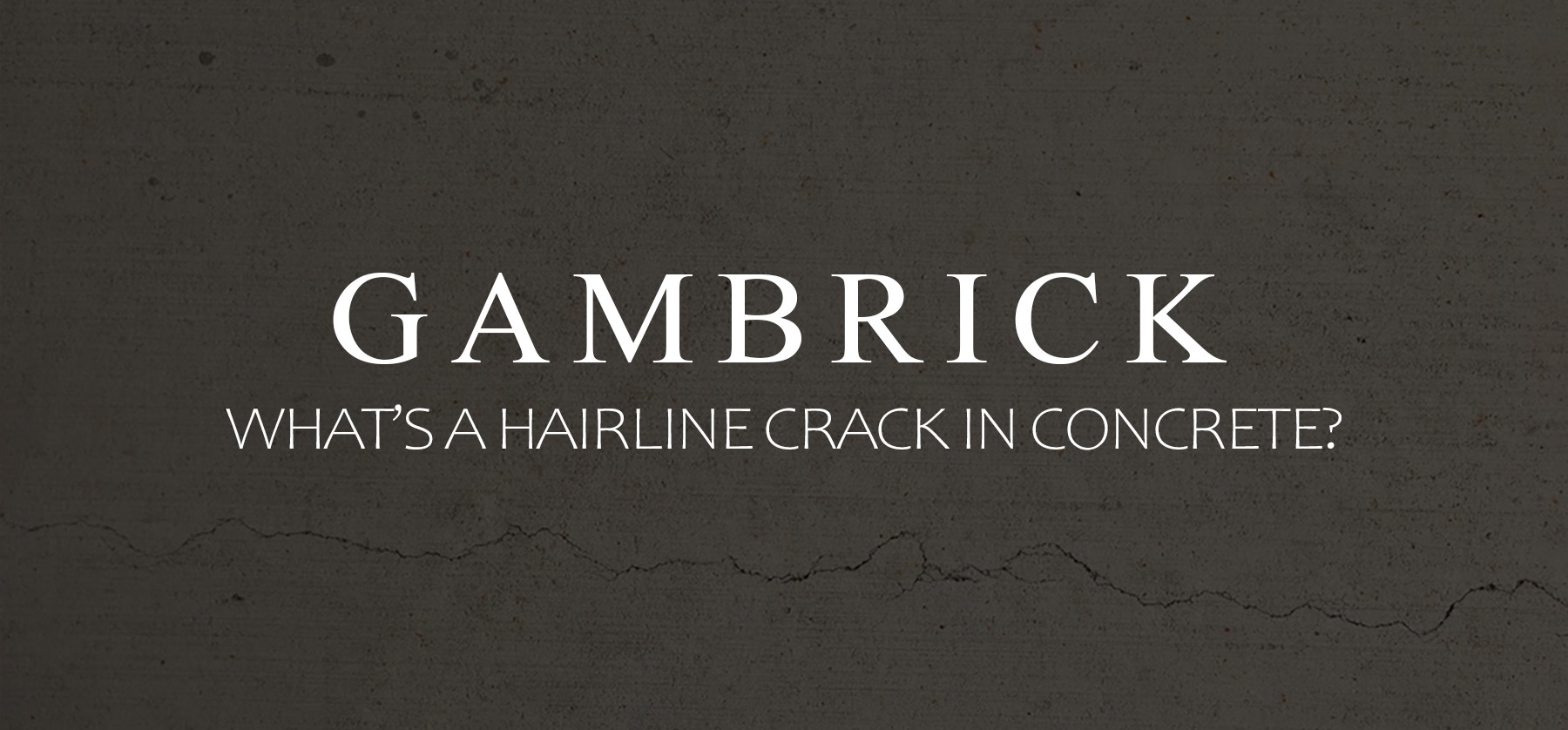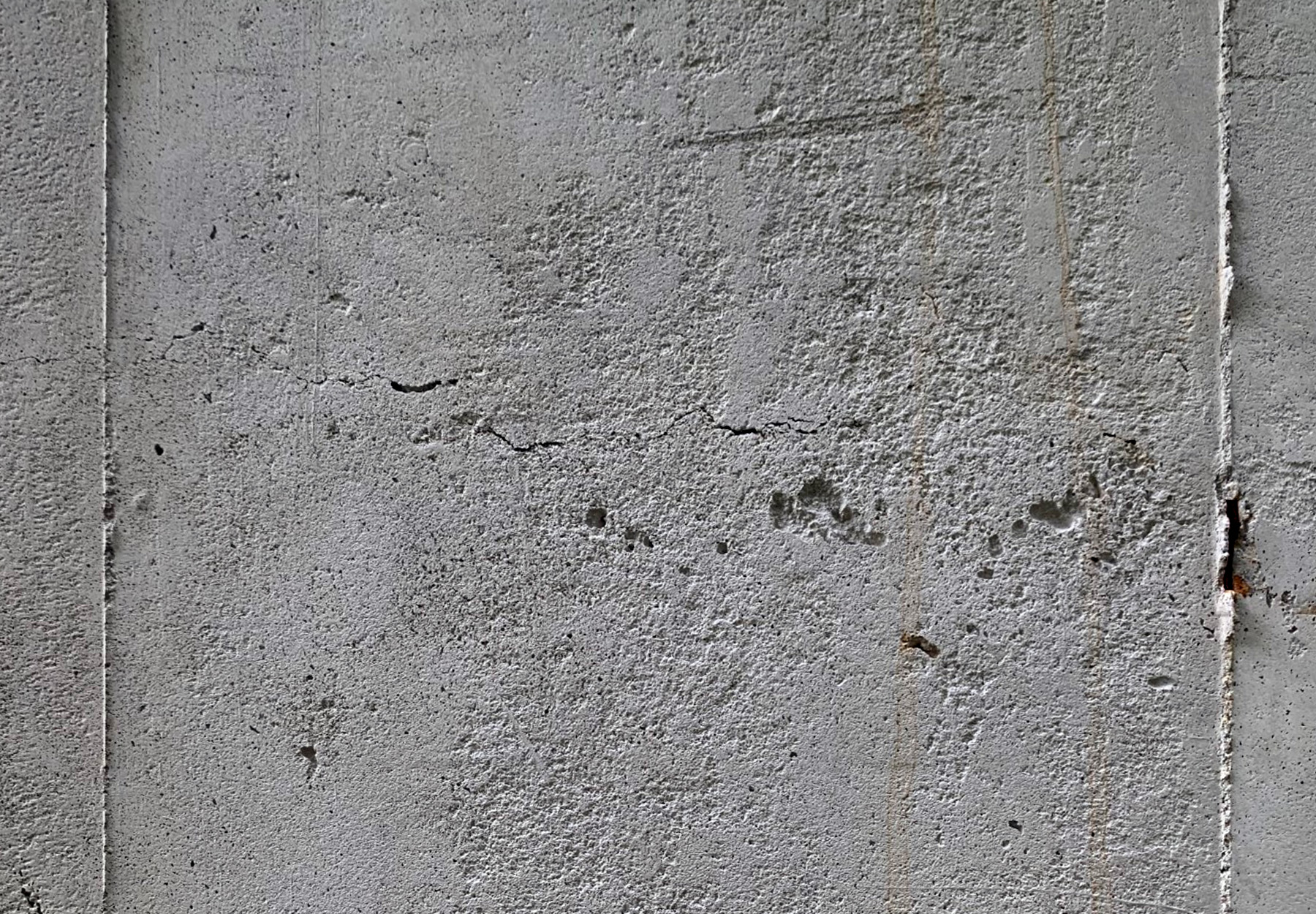
What’s A Hairline Crack In Concrete?
Hairline cracks in concrete are very narrow, generally about the width of a human hair. Anything larger would not be considered a hairline crack. They’re an acceptable concrete crack that’s very hard to prevent. They’re commonly found in freshly poured concrete and are typically caused by shrinkage. As concrete dries, cures and strengthens, it shrinks which can create tiny cracks. Generally the cracks are about .003 inches or .08mm in width. They’re usually shallow but the term hairline has to do with a crack’s width, not it’s depth, as some hairline cracks can be deep. And there’s is no way to determine a crack’s depth based on it’s width.
ACI 116R-90, Cement and Concrete Terminology, defines hairline cracks as cracks in an exposed concrete surface having widths so small as to be barely perceptible. This technical definition of a hairline concrete crack doesn’t provide an exact width, but you’d know one when you saw it because they’re very tiny. If you can see inside the crack, it’s probably not a hairline.
Hairline cracks can occur in just about any type of concrete. I’ve seen them in foundations, sidewalks, poured walls and cast products. Anything made out of concrete can develop cracks for a wide variety of reasons. All concrete starts off as a powder, is mixed with water, and then dries. The drying process is a very important part of concrete work and there’s no way to avoid it. But you can do a few things to manage it.
The best way to avoid hairline cracks is to cure the concrete slowly. Keep the concrete damp by adding water to the surface or covering it in plastic. A slower curing process not only helps prevent cracks, but also creates stronger concrete.
What Causes Hairline Cracks In Concrete?
The main cause of hairline cracks in concrete is shrinkage. Concrete is poured wet and then dries. As the concrete dries it becomes hard and strong. This process is called curing and can take a total of 28 days to complete. But it’s the first day that’s most important in terms of preventing hairline cracks. If the concrete loses moisture too quickly, tiny cracks can form. To prevent this, slow the drying process down by keeping the concrete’s surface damp. There are two main ways to do it.
- Cover the concrete with plastic sheeting for the first day as it dries. This will slow down drying and keep the surface moist.
- Lightly spray water onto the concrete’s surface to keep it moist.
There are a few other causes for hairline concrete cracks. Variations in air temperature, concrete temperature, relative humidity and wind can all cause them. All of these factors can cause excess evaporation in either hot or cold weather which is basically the same as drying too quickly.
Some other factors that can create hairline cracks are:
- Water loss due to absorption by the sub-grade, forms or aggregate.
- Bleeding
- Sedimentation
- Poor workmanship
- Alkali-Aggregate reactions
- Type and content of Portland cement
- Additional materials like fly ash, silica fume, etc.
- Type and amounts of chemical additives
- Improper screeding or other finish work

How To Prevent Hairline Cracks In Concrete
The most common cause of hairline cracks in concrete is drying too fast. So the best way to prevent them is to slow down the drying process. Rapid loss of moisture due to hot weather, dry air, additives, aggregate, chemicals, poor workmanship and more, can all be dealt with in a variety of ways.
- Keep the concrete surface moist by misting water on top of it. Don’t over saturate the concrete. You don’t want it soaking wet, just damp.
- Use plastic sheeting to cover the surface. This keeps evaporated moisture on the concrete.
- Use wind break barriers to reduce wind velocity.
- Shade the concrete to reduce surface temperatures.
- Dampen the sub-grade and forms before pouring concrete. This prevents them from sucking moisture out of the concrete.
- Spray on an evaporation retardant.
- Use microfibers or micro-rebar in the concrete mix to increase tensile strength.
- Don’t over work the concrete surface. Troweling and other finish work draws moisture to the surface.
- Be careful when adding colors to the concrete. They can suck water out of the concrete.
- Don’t add too much water to the concrete mix. This weakens the concrete, making it more prone to cracking.
How To Repair Hairline Cracks In Concrete
If you notice hairline cracks in your concrete don’t worry, there are a few things you can do to repair them.
Inspect & Clean The Cracks
The first step in repairing hairline cracks in your concrete is inspection and cleaning. If oils or other liquids have penetrated the cracks you should clean them thoroughly. If you repair the crack with a substance inside it can discolor the concrete and/or sealant.
A good way to spot hairline cracks in concrete is that they haven’t opened up. If you can see into the crack, it’s probably not a hairline.
Use Sealants To Repair Hairline Concrete Cracks
Repairing a hairline crack means sealing it with a sealant. Sealants are a filler material that’s used to penetrate into the crack and seal them. The best sealants should have low surface tension and viscosity. This allows the sealer to penetrate into the crack. There are a few sealants that work.
- Silicone or Latex Caulking. Both products are great for filling and sealing the crack. The downside is that they’re visible after the crack is sealed.
- Polymer-Modified Cement Grout. Another product that’s great for sealing hairline concrete cracks. Also visible after repair.
- Concrete Sealers and Epoxies. These sealers are used for the entire concrete surface, not just the cracks. This makes them less noticeable then spot repairs. But sealers wear off and need to be reapplied as needed.
- Paint. Paints are much thicker than sealers. They completely cover the entire surface and fill all the cracks. Paints don’t need to be reapplied as often as sealers do.
How To Apply Sealants
Always clean the cracks and concrete surface before applying a sealant.
Sealants that only fill the cracks, like caulks, are applied to the crack and smoothed. Hairline cracks are very small no only apply a very thin line of sealant. Smooth it out by pressing the caulk into the crack. You’ll be able to see the sealant when your done so try and get a color that matches the concrete as best you can or use a clear product.
Grout is applied just like caulk sealant.
Concrete sealers and epoxies are either applied with a squeegee or paint roller and brush. Cover the entire surface in one pass or you’ll see line marks. The good thing about these types of seals is that they not only fill the hairline cracks but also seal the entire slab against water and stains.
Concrete paint is typically applied with a roller for large areas and a brush for small spots. As with sealers and epoxies, paint the entire surface in one pass or you’ll see lines. It’s OK to fill the cracks with a caulk sealant prior to painting but be aware that the texture will be visible. Caulk sealers dry smooth but concrete is rough so you’ll typically see the repair spots through the paint. I recommend using a sanded grout sealer instead. It’ll seal the cracks and dry rough.
Curing
Sealants must be installed correctly and allowed to cure in order for them to work. Adjust the dry time according to the weather and temperature. The warmer the temperature, the faster your sealants will dry. The colder the temperature the slower they’ll dry.
Humidity effects curing time too. Dry climates dry sealants faster than humid ones.
Just as with concrete, sealants should be dried too fast. This can cause shrinkage and cracks.
Here are a few general rules of thumb I use whenever I apply concrete sealants.
- Don’t apply the concrete sealant at the hottest time of day. Wait for the sun to go down or apply them first thing in the morning. Adjust this based on the sealants recommended dry time.
- Never apply sealants when there’s a chance of rain within the estimated dry time.
- Don’t apply a sealant to wet concrete unless it specifically says you should.
- Clean the concrete of dirt and dust. Both will effect how the sealant adheres to the concrete.
- Don;t apply sealants in extreme conditions. Overly humid, dry, hot or cold are all bad.
- Too much wind can be bad for sealants.

Hairline Crack Repair Is Mainly Cosmetic
Repairing hairline cracks in concrete can be challenging because they’re so small. It’s easier to squeeze caulk and grout sealants into wider cracks. Generally there’s very little room to fill it with anything other than a low-viscosity liquid. This means sealing the entire concrete surface rather than just a spot fix may be your only option.
Since most hairline cracks don’t affect the structural integrity of the slab, sealing the crack is the main goal of the repair. It’s more of a cosmetic fix then when you’re dealing with larger cracks. But it should still be done because small hairline cracks can open up over time if ignored.
If you ignore a hairline crack it could eventually open up and become worse. Water penetration can chip the crack at the edges and create space for more water. Seal hairline cracks right away to prevent future damage.
Acceptable Concrete Cracks
Hairline Cracks in concrete are very common but misunderstood. When most people see a crack in concrete, especially when it’s new, they assume there’s a problem. But hairline cracks are typically nothing to worry about and mostly cosmetic. Although that doesn’t mean they should be ignored.
Hairline concrete cracks should not be ignored because they can get bigger over time. Moisture can get inside even the tiniest crack. Over time, hairline cracks can start to chip and open up. It’s best to seal them right away so water can’t get in.
Some small cracks in concrete are unavoidable. The best a contractor can do is try to control the curing process and mix as best they can. But sometimes, even when you do everything perfectly, hairline cracks still appear.
Controlling hairline cracks is done by properly preparing this sub-base and forms, using the correct amount of water, utilizing reinforcement where needed, and by slowing the curing process. Even with ideal conditions and proper installation, it’s sometimes impossible to deliver a completely crack free slab.
Hairline cracks can develop in concrete as it cures. But they generally do not cause problems with the stability of the concrete.
If cracks appear right after after pouring a concrete foundation, the concrete may have dried too quickly, been mixed poorly, or over worked.
In poured concrete foundations, hairline cracks commonly appear toward the center of the walls because the corners have more stability.
Hairline concrete cracks are generally considered an acceptable crack as long as they’re not widespread. Seal them if they occur and keep them from getting worse. For hairline crack repair, I suggest a good quality concrete sealer. A sealer will not only repair the small cracks but also the rest of the concrete slab by repelling moisture.
How To Hide Hairline Cracks In Concrete?
The best way to hide hairline cracks in concrete is to cover them up with paint. Painting the concrete completely eliminates the cracks from site while other forms of sealers can still be seen.
- Caulks and grout can be seen after the crack is repaired. Even if you match the color perfectly, a filler isn’t concrete, so it will age a different color. And the texture will be different too.
- Sealers are great at protecting concrete slabs and repairing cracks, but they’re transparent. You can still see the cracks through them.
- Paint is the only way I know of to completely cover and hide a hairline concrete crack.
Should You Fix Hairline Cracks In Concrete?
Yes. Hairline cracks in concrete should be fixed to prevent them from getting worse.
If a hairline crack isn’t sealed, moisture can get inside. Over time this can cause the edges to chip and the crack can open. Cracks are also a great place for organic material to settle which can cause mold and mildew growth. Especially in shaded, damp areas.
When you see hairline cracks, or any other type of concrete crack, seal them and the entire slab. This will not only spot repair the crack but also preserve the rest of the slab.
Summary: What’s A Hairline Crack In Concrete?
Hairline cracks in concrete are very narrow, generally about the width of a human hair. Anything larger would not be considered a hairline crack. They’re an acceptable concrete crack that’s very hard to prevent. They’re commonly found in freshly poured concrete and are typically caused by shrinkage. Although there are other causes which we’ll discuss later. As concrete dries, cures and strengthens, it shrinks which can create tiny cracks. Generally the cracks are about .003 inches or .08mm in width. They’re usually shallow but the term hairline has to do with a crack’s width, not it’s depth. Some hairline cracks can be deep. And there’s is no way to determine a crack’s depth based on it’s width.
ACI 116R-90, Cement and Concrete Terminology, defines hairline cracks as cracks in an exposed concrete surface having widths so small as to be barely perceptible. This technical definition of a hairline concrete crack doesn’t provide an exact width, but you’d know one when you saw it because they’re very tiny. If you can see inside the crack, it’s probably not a hairline.
Hairline cracks can occur in just about any type of concrete. I’ve seen them in foundations, sidewalks, poured walls and cast products. Anything made out of concrete can develop a hairline crack because of the curing process. All concrete starts off as a powder, is mixed with water, and then dries. The drying process is a very important part of concrete work and there’s no way to avoid it. But you can do a few things to manage it.
The best way to avoid hairline cracks is to cure the concrete slowly. Keep the concrete damp by adding water to the surface or covering it in plastic. A slower curing process not only helps prevent cracks, but also creates stronger concrete.
If you have any questions or comments about hairline concrete cracks, Email any time.

John Mazzuca | About | More Posts |
Custom Home Builder
John Mazzuca is a custom home designer and builder at Gambrick with over 25 years experience in the construction industry. John has designed, built and/or remodeled hundreds of homes, small buildings, and commercial projects. He writes about business, real estate, home building, and household electronics. His work has been featured in Fox Business, Better Homes & Garden, House Beautiful, and more.




















